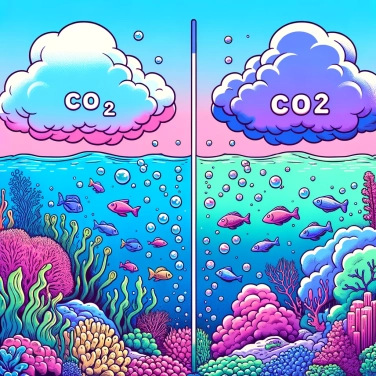Carbon dioxide present in the atmosphere is absorbed by the oceans, forming carbonic acid which decreases the pH of seawater, thus contributing to ocean acidification.

Carbon dioxide or CO2 is naturally present in the atmosphere, where it acts as a greenhouse gas. Without it, it would be very cold on Earth, as it is thanks to it (among other factors) that our atmosphere retains some of the sun's heat. However, since the Industrial Revolution, we have been emitting much more CO2, primarily by burning fossil fuels such as coal, oil, or gas. Over time, these large additional quantities of CO2 have amplified the natural greenhouse effect, leading to the current well-known global warming. The catch is that a good portion of all this extra CO2 does not remain solely in the air: the oceans also absorb a huge amount, which poses some real issues.
When the carbon dioxide present in the atmosphere comes into contact with the surface of the oceans, it is naturally absorbed. The more atmospheric CO2 increases, the more the ocean acts like a large sponge that sucks up the gas. Once this CO2 is trapped in the water, it does not remain still: it reacts with water molecules and gives rise to a new element called carbonic acid. This carbonic acid does not remain stable for long: it quickly releases bicarbonate ions and especially hydrogen ions. And it is precisely this additional supply of hydrogen ions that dangerously lowers the pH of seawater, in simple terms: it acidifies the ocean. The more acidic the water becomes, the more it disrupts all sorts of processes essential to marine life.
When carbon dioxide (CO₂) enters seawater, it reacts with water molecules. This interaction gives rise to what is called carbonic acid (H₂CO₃). And this acid, even though weak, is enough to disrupt the natural balance of the oceans. It releases hydrogen ions (the infamous H⁺), the main culprits of acidification. The more H⁺ ions there are in the water, the lower the pH becomes, making it more acidic. This slight decrease in marine pH severely disrupts aquatic life, quickly altering a balance that nature has taken thousands of years to establish.
Acidification seriously complicates the lives of shellfish organisms (such as oysters, mussels, or tiny pteropods) by reducing their ability to produce their protective shell made of calcium carbonate. This loss of protection weakens the entire marine food chain, as these small creatures directly or indirectly serve as food for many species like fish, seabirds, and marine mammals. Coral is also suffering greatly, as acidity slowly dissolves its limestone structure, directly threatening coral reefs, which are true nurseries of marine biodiversity. These reefs are home to thousands of species: colorful fish, crustaceans, algae... less coral means much fewer fish and a significant loss of underwater diversity. The fish themselves are seeing their growth, reproduction, and even their sense of direction disrupted by changing pH levels. As a result, stressed and disoriented fish lead to diminished food resources for human communities dependent on fishing.
Ocean acidification directly impacts key economic sectors, such as fishing and coastal tourism. It's important to know that the number of fish and seafood largely depends on the health of coral reefs and shellfish, which are highly sensitive to increasing acidity. Fewer shellfish, shrimp, crabs, and fish to catch means less income for those who rely on the sea. We're not just talking about small artisanal fishermen, but also entire industries, local markets, tourist restaurants, and whole coastal communities. All of this leads to job losses, severely impacts the local economy, and forces people to find new ways to live and work. Essentially, acidification is not just bad for fish, but also for humans who depend directly or indirectly on a healthy ocean.
Each year, about a quarter of the carbon dioxide emitted by human activities is absorbed by the oceans, thereby directly contributing to their acidification.
Some oceanic regions, such as the west coast of North America, are already experiencing severe episodes of seasonal acidification, which have concrete economic effects on local communities.
Ocean acidification not only dissolves shells and marine skeletons; it also affects the behavior and survival of fish by disrupting their sense of orientation and their ability to avoid predators.
Did you know that since the beginning of the industrial era, the average acidity of the oceans has increased by about 30%, primarily due to the rise in atmospheric CO2?
Acidification directly impacts significant economic sectors such as aquaculture, commercial fishing, and coastal tourism. For example, the decline in available shellfish affects the profitability of aquaculture farms, and the reduction of coral reefs results in losses for maritime tourism.
Indirectly, yes. Acidification disrupts marine food chains by reducing biodiversity and the availability of nutrient-rich fish and seafood (such as omega-3s). These reductions could ultimately have consequences for human nutrition and health, especially in populations that rely on seafood.
Carbon dioxide (CO2) present in the atmosphere naturally dissolves in seawater through a process called gas diffusion. When the atmospheric concentration of CO2 increases due to human activities, more molecules cross this air-water interface, resulting in a gradual increase in ocean acidity.
Ocean acidification alters marine chemistry, making it more difficult for various marine organisms such as corals, mollusks, and calcareous plankton to form and maintain their shells and skeletons. These cascading disruptions can lead to a significant weakening of marine ecosystems and a substantial reduction in their biodiversity.
Yes, the main approach is to significantly reduce global carbon dioxide emissions. Complementary actions include the restoration of seagrasses and mangroves, which can capture and store CO2, as well as innovative carbon sequestration techniques. However, completely reversing the acidification that has already occurred could take decades, if not centuries.

No one has answered this quiz yet, be the first!' :-)
Question 1/5